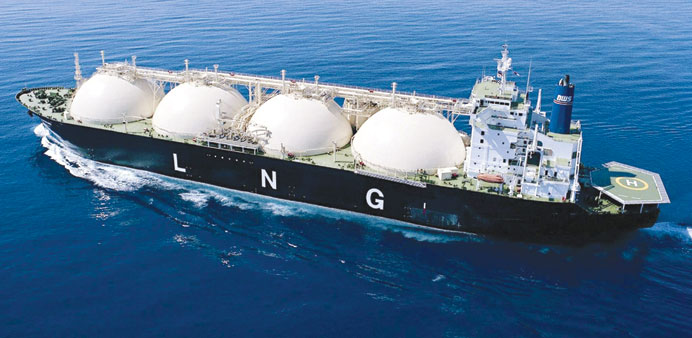|
|
An Australia LNG ship sails off the coast of Western Australia (file). Australia likes to think of its LNG projects as its very own Apollo Moon programme, which is appropriate as they are likely to keep the country’s currency in orbit for years to come.
Reuters/Sydney
Australia likes to think of its LNG projects as its very own Apollo Moon programme, which is appropriate as they are likely to keep the country’s currency in orbit for years to come.
While the whole world is very much not watching this time, the $200bn being spent on liquefied natural gas projects in Australia is much the same in real terms as what the US spent sending a man to the moon.
Australia has surpassed Qatar as the largest supplier to Japan, the world’s single biggest buyer of the super-cooled fossil fuel, and with another $100bn of projects under review, it could well become the Saudi Arabia of LNG.
Exports of the gas are expected to rake in over $16bn this year and to more than quadruple by 2017, a wholly new source of strength for the Australian dollar that is little recognised right now.
The deeply liquid currency, known as the Aussie, is the fifth most traded in the world and a favourite proxy for trends in global growth and commodity prices.
In particular, the rise of LNG exports has been so rapid that a favoured yardstick used to assess the fair value of the Aussie is likely being understated.
The Reserve Bank of Australia’s (RBA) index of commodity prices attempts to mirror price changes for Australia’s particular mix of resource exports and has a high correlation with trends in the currency.
Yet the weighting of commodities in the index has not been updated since 2009, when LNG was in its infancy. Back then the gas only accounted for 5% of the index, which was just a third of the share taken by gold exports.
But such is the growth in LNG that it is now accounting for almost as much in export earnings as the precious metal.
The central bank is due to update the index soon, which should result in some large changes in weightings.
Most banks around the world which trade the Aussie have their own models for it, which would include the RBA index.
Prices for LNG have been very strong, thanks in large part to increased demand from Japan following the closure of much of its nuclear power industry in the wake of the devastating March 2011 earthquake and tsunami.
The spot price of Japan-bound LNG has risen 91% from just before the disaster. Japan imported 87mn tonnes of LNG in 2012, up by a quarter from 2010.
Economists EnergyQuest estimate Australia provided 18% of those imports, taking it past Qatar as the biggest supplier for the first time.
All of which suggests LNG is being undercounted in the RBA’s commodity index, and making it lower than it otherwise would be. That in turn implies the Aussie is not as “overvalued” as some models suggest.
That could be one reason why the close relationship between the Aussie and the index became unglued last year as the currency rose even as the index retreated.
The RBA’s index has bounced recently but is still almost 23 points below its all-time peak of 149.8, as measured in IMF special drawing rights. In contrast, the trade weighted index of the Aussie is just a whisker from its highest levels since 1985.
Reuters latest global poll of 51 analysts found the median prediction was for the Aussie to be around $1.0100 in 12 months’ time, which would mark the third straight year it has stayed at or above parity. Since it was floated in 1983, its average value had been around 75¢.
The RBA would certainly prefer it if the currency was lower to relieve competitive pressure on domestic industries, notably manufacturing. But neither does it think the currency is so high that something has to be done about it.
Internal models used by the bank suggested the Aussie was around 7% above fair value back in December, which officials described as “a bit overvalued”.
“The mix change towards sustainably higher priced LNG exports already accounts for around four US cents of the AUD/USD in fair value terms, on the RBA commodity price series,” estimates Geoffrey Kendrick, a forex strategist at Nomura in London.
“The impact of this adds a further explanation of the gap between commodity prices and the AUD,” he adds. “If anything, this bias will only increase as the pace of LNG productive capacity expansion increases.”
Output will really start to ramp up from 2015 as some major projects come on stream. The government’s main resource forecaster expects gas exports to more than double in volume by 2016, and triple the year after.
Much of this gas has already been sold in multi-decade contracts tied to the price of crude oil, which could lend the Aussie some of the characteristics of a petro-currency.
The buyers are a range of giant power generators in Japan, South Korea and China, which should make the gas a more reliable earner than the current export leader iron ore. Prices for the steel making mineral are essentially determined by demand in China alone, making them very volatile.
The spread of buyers and long-term nature of contracts offer hope that the LNG trade can avoid repeats of what happened last year when spot iron ore prices plunged 36% between August and September, dealing a painful blow to mining profits.

